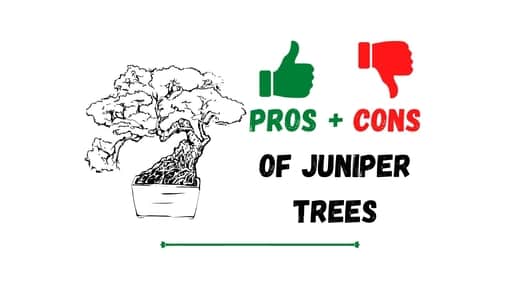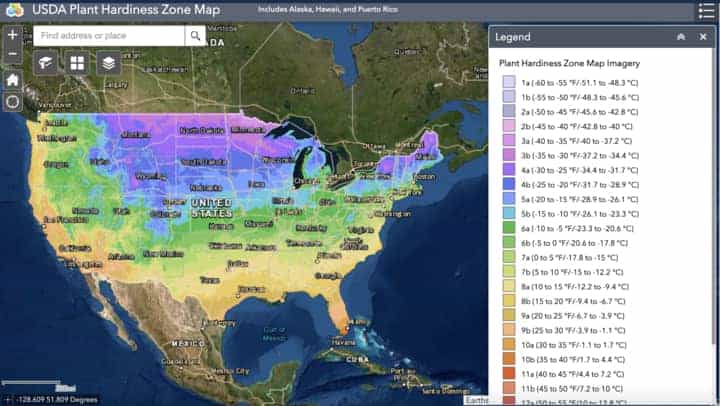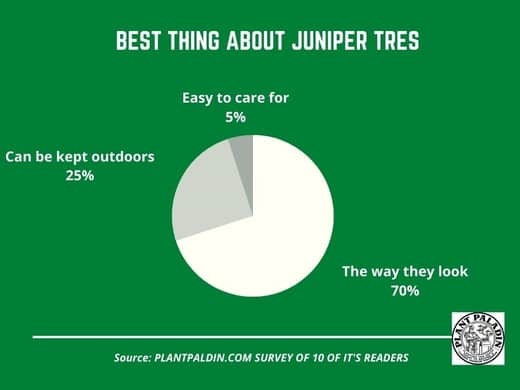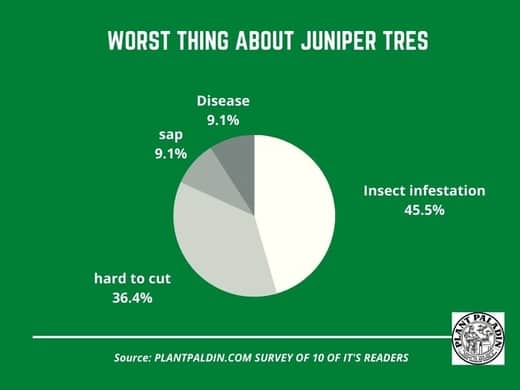This website is supported by its readers. If you click one of my links I may earn a commission. I am also a participant in the Amazon affiliates program and I will also earn a commission from qualified purchases.

With over 60 sub-species, Juniper trees are amongst the most popular tree species available globally. These trees are increasing rapidly in popularity. I recently wanted to purchase a new Juniper myself, so I asked, what are the pros and cons of Juniper trees?
The pros of keeping a Juniper tree include:
- Juniper is both heat and cold-resistant.
- Having a long lifespan.
- Making excellent hedges and bonsai trees.
The cons of keeping Junipers include:-
- pest and insect infestations
- The sap content,
- Not being able to keep them indoors.
So what are these exact pros and cons? And when should you avoid purchasing a Juniper tree? Keep reading to find out more!
Just a quick heads up, over the past three years of running Plantpaladin, hundreds of people have asked for product recommendations. As such, You can find my favorite indoor bonsai tree here (link takes you to Bonsaiboy), my favorite outdoor bonsai tree (link takes you to Bonsaiboy), or have a look at all the products I recommend here.
Pros and cons of Juniper trees
Walk through any forest, drive into any suburbs or visit any country, warm or cold, and the humble Juniper tree will be present.
With more people working from home than ever, these trees are increasing in popularity as people look to add a dash of greenery to their homes and gardens.
I, too, was looking for a new Juniper to add to my collection.
So I got in touch with my local botanical gardens and Kew Botanical Gardens, reached out to some experts there, and even asked 10 Plant Paladin readers what they like and don’t like about their Juniper trees.
Having grown Juniper, I also have my own opinion on the pros and cons of Juniper trees.
All this to ensure you have the best post on the exact pros and cons of Juniper trees.
To summarise:
- The main pros of Juniper trees are that they are evergreen, are both heat and cold resistant, can be kept outdoors year-round, and make for excellent bonsai and hedges.
- Other advantages include that these trees live for long and come in 60 different subspecies.
- The main cons of keeping Juniper trees are the initial cost of buying a Juniper, the fact you can’t grow these trees indoors, insect and bacterial infections, the amount of sap these trees have and being more challenging to prune than deciduous species.
Pros and cons of Juniper trees – comparison table
Pros of keeping Juniper | Cons of keeping Juniper |
Leaves don’t fall off | Older species can cost a lot |
Cold-resistant | A lot of sap |
Heat and drought resistant | Hard to prune |
Multiple sub-species | Can’t be kept indoors |
Can be kept outdoors year-round | Can get disease |
Make for excellent bonsai | Pest infestation |
Great for use in shrubs and hedges | Can be messy with their berries |
Long Life | Pets can choke on their tips |

Pros of keeping a Juniper tree
Let’s explore the above points in more detail, starting with the pros of keeping a Juniper tree.
They are evergreen
The first significant pro that Juniper trees have over other tree species is that they are evergreen coniferous trees.
While choosing conifers over deciduous trees is as much a personal choice as anything else, one of the most significant advantages evergreen trees like Junipers have is that they keep their leaves year-round.
Instead of having a tree that looks dry and brittle throughout the winter months, these trees will have full thick needles/tip-like leaves throughout the year.
Better yet, all of the 60 sub-species of Juniper are coniferous, meaning you won’t have to worry about picking a species that will drop its leaves!
If you want a tree to add greenery to your outdoor space year-round, Juniper will make for a fantastic option.
Cold-resistant
Another entry on the list of pros and cons of Juniper trees ahs to be junipers bieng cold resistant.
Cold climates are one of the most considerable problems with growing and keeping trees.
I am from the UK, which is pleasant enough during the summer but often faces bitter winters.
Getting a tree that can make it through the winter while being kept outdoors is a definite challenge.
Thankfully Juniper trees are incredibly hardy and have no problem dealing with the cold.
Some Juniper sub-species, for example, the Russian Juniper, can withstand sub-zero temperatures for prolonged periods without suffering real damage.
Most Juniper trees then will have no problem surviving winter outdoors so long as temperatures do not drop below – 10 degrees Celsius or 15 degrees Fahrenheit.
These trees can then be grown in USDA hardiness zones 8a and above.
To read up more on this, feel free to check out my post on winterizing Juniper here or check out the image below to see where your climate compares:

Heat resistant
Now you might think if Juniper trees are hardy and cold-resistant, this must mean that they are pretty poor at dealing with heat and sunlight, right?
Not at all!
Juniper trees do very well in dry arid climates and are one of the reasons they grow on every continent.
Juniper trees then will have no trouble making it through most hot summers and easily withstand temperatures up to 90 degrees Fahrenheit (32 degrees Celsius).
If temperatures exceed this for a few days, such as during a heatwave, Junipers can adapt to these warmer conditions.
If temperatures exceed 90 degrees for a few weeks on end during certain times of the year, you may want to wrap your Juniper as you would any drought-tolerant tree in extreme weather conditions to prevent them from burning.
Drought resistant
So with heat comes watering.
Another significant benefit of Juniper tree species, however, is that Junipers are drought resistant, unlike other trees such as Willows, Oak, or Elm trees that require a lot more watering during warmer conditions.
If you have to vacation or spend some time away from your Juniper, you can do so without worrying about your branches drying up and dying.
For best results, water when the topsoil of the Juniper is dry to touch.
If the topsoil is dry, then your Juniper needs watering.
Use rainwater or water from a watering can for best results.
Typically you will want to water your Juniper tree once or twice per week, depending on how moist the soil is,
Now, if you do happen to go on vacation or are away from your Juniper tree, fret not; you can get away with watering once in 2 weeks so long as you do not make this a repetitive occurrence.
Kept outdoors year-round
Without a doubt, one of the best advantages of keeping Juniper trees has to be the fact that you can leave them outdoors year-round.
I now own quite a few bonsai trees; unfortunately, some of them, such as my Ficus, can’t be kept outdoors due to low temperatures.
As Juniper trees are hardy, they can be left outside with minimal winterization.
The only caveat to this will be if temperatures drop below 15 degrees Fahrenheit for too long (i.e., more than two weeks)
As such, throw a bit of mulch on your Juniper’s topsoil; it should be good to survive outdoors during cold winter.
Better yet, some Juniper trees can grow pretty large, so not having to wheel them in and out of a garage or another cool spot is ideal if you want a tree that requires minimal work.
Many different species
Another great pro of keeping Juniper trees is that it is not just one tree but made up of over 60 different species.
If you want a tree with darker or lighter needles, there will be subspecies.
For example, if you want to keep a Juniper tree for bonsai, then Chinese or Japanese Juniper will be ideal.
Alternatively, Russian Junipers will be a good option if you live in freezing conditions and want a Juniper that can handle it.
With 60 sub-species, the amount of variety and scope to ensure you have the perfect Juniper that meets your needs is endless.
Make for excellent bonsai
We touched upon this earlier on, but one of the things I love most about Junipers is that they make for excellent bonsai.
Flashback to the Karate Kid, it’s a Juniper tree that you see on the back of Daniel-San’s gi, and for a good reason.
These trees are relatively straightforward, work very well in a miniaturized environment, and can be successfully grown into works of art without really damaging the tree.
While these might not be the most beginner-friendly bonsai tree ( I would recommend a Ginseng Ficus or Chinese Elm if this is your first go-around), they are undoubtedly the most beautiful.
Again consider investing in Chinese or Japanese Juniper to get the best results for your Juniper bonsai tree.

Make for excellent hedges
Aside from bonsai, Juniper can be used for other horticultural activities.
Most Junipers start as shrubs and so can make for excellent Hedges.
One species, in particular, Hetzii Columnaris, is a very fast-growing species of Juniper that likes to climb tall.
This tree can work very well then at blocking wind, sunlight, and prying eyes, giving you a bit of privacy that other tree species will not provide you.
Southern red cedars also do a fantastic job creating hedges and require minimal pruning.
Both these species can be grown very quickly in most mild climates.
Live for long
The last major pro of keeping Juniper trees is how long they can live.
Most Juniper trees, regardless of subspecies, can live from 200 to 700 years if grown in the right conditions.
Alternatively, if you are using Juniper to create a bonsai, these can live for upwards of 100 years and are one of the reasons why the oldest bonsai trees in the world are Juniper or Juniper sub-species.
If you are interested in a tree that will last well beyond your lifetime to be enjoyed by your family, friends, and the wider community, consider investing in a Juniper tree.
Cons of Juniper trees
Not every tree is perfect, so Juniper trees also have several cons you need to be aware of.
These include
Expensive
The biggest con that Juniper trees have is the cost associated with them.
While you can buy some common species, such as Irish Junipers, for $25 to $30, most premium species of Juniper used in bonsai can fetch upwards of $200 to $300, depending on the tree’s age.
If you are after a species of Juniper that is more bespoke, less common, and older, then be prepared to spend the big bucks when purchasing a Juniper tree.
On top of this, if you are using Juniper for a hedge or bonsai tree, then be prepared to spend extra money on drainage pots, shears, soil, and other accessories required for these activities.
A lot of sap
It’s a well-known fact that most common houseplants, such as Chinese Elm, contain a lot of sap.
This sap is located in the sapwood of Juniper trees and helps nutrients flow and enter all aspects of the tree.
The downside, however, for Junipers is that they tend to build up a lot of sap in the early spring.
Spring is when you would trim or prune back Juniper tree, so if done incorrectly can lead to a lot of mess or, worse yet, bacterial infections.
For best results, ensure you trim your Juniper where there is less energy/sap in the tree.
Summer works best and is one of the reasons why I strongly recommend repotting it in the summer.
Not as easy to prune
One of the most distinctive features of Juniper trees is the small needle/tip-like leaves that are commonplace in evergreen coniferous trees.
These leaves can make trimming back excessive leaf growth or defoliating your tree much more difficult.
While deciduous and semi-deciduous trees have entire leaves that grow on the petiole of the tree, it is more difficult to find the origins of the tips on the branches of your tree.
Not finding the beginning of the lead can lead to many people trimming the leaves of a Juniper tree in one cut, which can lead to uneven growth of your leaves when they grow back.
Instead, if you want to reduce the number of leaves in your Juniper, the better option will be to twist and pick them by hand.
While this will be more time-consuming, it will make pruning the tree more accurate.
Now for larger shrubs used in hedges, I strongly recommend trimming Juniper at its branches to save time.
You can’t keep it indoors
As I mentioned earlier, one big reason people keep Junipers is to add bits of greenery to their homes.
Indoor plants are popular, and many people I know want to keep Junipers.
Herein, however, lies the problem.
As Junipers are hardy and drought-resistant, they need to be kept outdoors and do not perform well when kept indoors.
Junipers require a lot of sunlight and prefer being kept in the ground than moved around frequently.
These trees often need the wind to strengthen their branches and roots.
Keeping them indoors, where the air is dryer and does not flow near as much as it does outdoors, can weaken your Juniper.
The only exception would be Juniper you keep for bonsai.
Juniper bonsai can be kept indoors in colder environments for short periods.
Even these, however, will benefit more from being kept outdoors than indoors.
Can grow large
Look up evergreen trees, like Junipers, on any search engine, and you will usually see pictures of giant evergreen trees that stand 30 meters tall.
Juniper trees average between 5 to 10 inches of growth per year.
As these trees live for so long, they can grow into small giants over time.
This growth can then damage underground pipes and sewage or even cause cracks in pavements/sidewalks and other nearby objects.
As such, you should ensure when growing a Juniper, you get a good understanding of its surrounding areas before deciding where exactly you will place the tree.
Disease
Like all houseplants and shrubs, disease and bacterial infections are commonplace in Junipers.
The biggest would have to be root rot.
As Junipers are kept outdoors, it can be very easy, especially in rainy climates, for these trees to become overwatered.
This overwatering causes fungi such as Pythium, Phytophthora, Rhizoctonia, and Fusarium to build up in the potting soil of your tree.
These fungi then cause the roots of your tree to become saturated and unable to transport water, oxygen, and nutrients from the soil to the rest of your tree.
White spots or powder on the tips of your Juniper tree and stunted growth are the main symptoms of root rot/bacterial infections.
Other common infections include bacterial infections, which can cause sap to ooze out of the tree.
Insects
Similar to the point above, as these trees are kept outdoors year-round, it can be widespread for insects and other animals to burrow and nest in and around your tree.
Spider mites, Aphids, Scale, Whiteflies, and Caterpillars will be your biggest culprits, however, do not be surprised to find Slugs, Squirrels, and birds nesting near your Juniper too.
More giant Junipers have a dense canopy that can protect these pests from the elements.
You can treat many bugs via parasitic wasps, ladybugs, or chemical pesticides.
Ensure you regularly check for signs of insect infestation to ensure your Juniper stays in the best conditions possible.
Bad for cats
While Juniper trees are not toxic to cats per se, one problem I have seen in the past is cats chewing on and choking on the needle or tip-like leaves these trees have.
The small leaves can easily be caught in a cat’s esophagus.
If you live in an area with several cats that have not been trained, reconsider investing in a Juniper tree.
Messy berries
Some sub-species of Juniper contain berries/seeds used in beverages and food products.
While this is good for those of you keeping junipers to cultivate these crops, many wild Juniper in suburban neighborhoods also grows these berries.
While they only weigh 1 to 2 grams per berry, these berries can often litter the floor in and around your Juniper, attracting birds’ pests and generally causing a mess.
These berries can also propagate relatively quickly, meaning if you do not take care of them, you can be left with Juniper spores starting to grow near your tree.
Should you buy a Juniper bonsai?
You should purchase Juniper bonsai trees once you have experience in growing bonsai trees from other species such as Ficus or Elm. While these trees are generally easy to care for, Juniper requires slightly more care due to the tip/needle-like leaves and excess sap these trees contain.
My recommendation for Juniper bonsai would be to purchase one once you have one to two years of growing a regular bonsai tree successfully.
When to avoid buying a Juniper tree?
You should avoid Juniper trees if you live in a small confined indoor space with no outdoor access. Juniper trees thrive in outdoor conditions and so keeping these trees indoors will not benefit your Juniper tres health overall.
How to care for a Juniper bonsai tree?
Many of you will be reading this to take care or decide if you want a Juniper bonsai tree.
I have come up with a table below showing how to care for a Juniper bonsai below:
Apple bonsai tree requirements | Explained |
Water | 3 times per week in the spring and summer. Once to twice per week in the winter. |
Sunlight | 4 hours of direct sunlight per day. |
Temperature | 14 to 85 degrees Fahrenheit |
Fertilizer | once per month in the spring and summer - avoid in fall and winter. |
Repotting | Once every 2 to 3 years |
Placement | Outdoors only |
Species Type | Coniferous |
Wire type | Both copper and aluminum |
Time to grow from seed | 3 years |
Potting Soil | Inorganic mix of akadama and volcanic ash rock. Organic soil such as peat soil can also be used. |
Growth type | Medium growth - adds 5 to 12 inches per year in height. |
Size | Medium to large, most trees sold is typically two hand bonsai. |
Lifespan | 500 years + |
What Juniper species is the best?
Common Juniper trees are the most accessible Juniper trees for most people to care for. If growing Juniper for bonsai, considers investing in a Chinese or Japanese Juniper tree. If using Juniper for a hedge, use Southern Red Cedar.
Study on the pros and cons of Juniper trees
Finally, I asked 10 plant paladin readers what they liked most and least about their Juniper trees.
You can read up on the results below:


I also asked an employee at Birmingham botanical gardens what the pros and cons of Juniper trees was:
“The best thing about our Juniper bonsai is the way they look. The worst thing is the amount of time it takes to make them that way.”
My top picks for the gear you will need!
So like I mentioned earlier, over the past three years of running PlantPaladin, hundreds of people have asked me for my recommendations on the best bonsai gear on the market.
Having spent thousands of dollars on bonsai items these past few years and tested at least 100 bonsai-specific products, I’ve listed my favorite products below – All of which I highly recommend and think you can get great value.
They can purchase directly by clicking the link to take them to Amazon.
Bonsai Tool Set: One of the significant challenges I’ve had is finding a toolset that was not only durable but didn’t break the bank. SOLIGT has recently developed a fantastic bonsai tool set that covers all the tools you need to trim, prune, and repot your trees. – You can grab it here.
Complete Bonsai Set: Many of you will want to grow your bonsai trees entirely from scratch, but finding the varicose seeds, pots, and other items in one place can be challenging. Leaves and Sole then have created a complete bonsai set that I’ve personally used that ticks all the boxes. You can grab it here.
Bonsai wire: The number of times I’ve run out of wire for my bonsai or purchased cheap bonsai wire that doesn’t do the job is embarrassing for me to admit. After a lot of trial and error, I found that using Hotop’s aluminum bonsai wire is one of the best options on the market. This can easily be used for both indoor and outdoor bonsai. You can grab it here.
